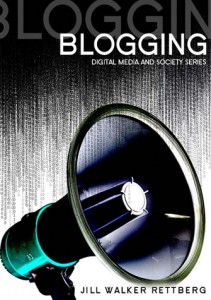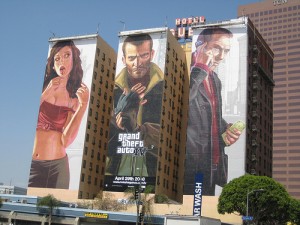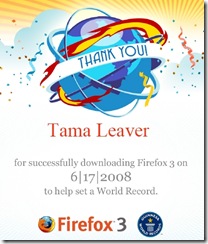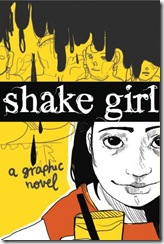Home » Ponderings (Page 3)
Category Archives: Ponderings
Blogging (the book) by Jill Walker Rettberg

I’m delighted to see that Jill Walker Rettberg’s book Blogging has just been released. I had the pleasure of reading much of this book in draft form last year while Jill was a guest researcher here in Communication Studies here at UWA, and on the basis of what I read I’m confident this book will be extremely well received. Jill’s work is neither a simple how-to guide (of which there are many), nor is it a book on blogging which presumes readers are already blogosphere aficionados. Rather, Jill has managed to write an engaging and critical book which situates blogging within broader histories – such as the role of blogging in terms of literacy, the evolution of citizen journalism, blogs and/as social networks, and even ethical frameworks which examine advertising and authenticity in blogs. More to the point, for someone new to blogs as an idea, or in practice, Blogging offers a world of insight and experience distilled into a readable and engaging form.
The table of contents and the (extremely positive) early reviews of Blogging are available on Polity’s website, and it can be ordered now from Amazon UK or will be available from Amazon US in about two months.
I strongly recommend you read Blogging for yourself!
Firefox 3 … Go Get It … Today!
Unless you’ve been hiding under a digital rock, you’d know that the best browser in the world has released an even better incarnation: Firefox 3 is here. I could write about all of its improvements, but you can get a fuller version here, suffice it to say it runs faster, takes a lot less memory (20 tabs open suddenly takes about 300mg less RAM for me!) and has some spiffy new security features. And let’s not forget, it’s an open source creation, made by the people, for the people!
To celebrate, Mozilla are encouraging people to download Firefox 3 today, attempting to break the Guinness World Record for most downloaded software in a 24hour period. For those of us in Perth, that 24 hours runs from 1am Wed 18 June until 12.59am Thurs 19 June. So, be part of a World Record and download now! I was the 29005th person to download from Australia, so I know there are a few Aussies who could download yet! And just in case you need one last ounce of motivation, downloading FireFox 3 today will get you a cute little certificate:
Seriously: go download it now.
Creative Juices
During the last semester, I’ve been coordinating a fun little honours unit which was called ‘Creative Selves’. One of the main ideas we explored was the ways in which ‘creativity’ is defined and deployed so differently across all sorts of areas from the creative industries to education and marketing. I wish I’d had this little video to start off that conversation:
[Via]
A Floating City

A simply beautiful design for a future Floating New Orleans as noted by Inhabitat:
It’s been almost three years since New Orleans weathered Katrina’s wrath, and debate still rages over plans to reconstruct the sunken city. Myriad options have surfaced ranging from rebuilding the levees to designing storm resistant structures to not rebuilding at all. Here’s an approach that endeavors to ride the river rather than stem it’s course. Harvard Graduate School of Design students Kiduck Kim and Christian Stayner have conceived of a Floating City that will “rise safely in an Archimedean liquid landscape.”
So elegant, so well designed and such a good way to work with the natural demands of a place rather than fortify against it. [More] [Via]
Best of Student News
On Tuesday, the students from my Digital Media class, as well a few invited guests and colleagues, enjoyed a screening of the Best 8 Student News Projects from the unit. This project, the first major assignment for the unit, takes place after 4 weeks of workshops which introduce digital video cameras, sound recording and (very) basic lighting, non-linear editing and copyright in media production. It’s a bit of a whirlwind, but the culmination of these workshop is a project in which students, working in groups of 4 or 5, get exactly one week to produce a 3 minute news story on the basis of pre-assigned topics (all of which are based on relevant local issues).
Once the projects are completed, part of the feedback process is not just comments from myself or Christina (who is tutoring half of the classes, I’m tutoring the other half) – although we do give a fair bit of written feedback – but we also have a reflective seminar where the projects completed by the groups in these seminars (there are 4 groups in each seminar) are viewed and the other members of the seminar offer written and verbal feedback. I find this is always a very rewarding process, as students often engage more directly with peer feedback. To top it off, at the end of each seminar (there are 8 ) each seminar votes and the best project, along with the top from the other seminars, become those which make up the Best of Student News screening. While I am a little hesitant to place too much weight on the ‘best’ projects – learning is, after all, not a competition – students nevertheless respond well to this voting process. I suspect the idea of them deciding the best projects rather than the course staff is very appealing! Then, in the Best of Student News screening, the students get to vote once more and select their choice for the Best Student News Project of the year.
I have to say, I think the level at which students produced their projects this year has been outstanding. Even though most of them have learnt their media production skills over 4 one and a half hour workshops, many of these projects can stand up against the work of professionals who’ve had 3 year of training. The Best Project for the year, as selected by their peers, shows that humour – when used properly – really is one of the universally appealing elements of media. So, without any further ado, this year’s Best Student Project takes a comical look at the role of community radio in the era of media conglomeration.
At the screening, there is also a Staff Award given the the project which got the highest overall mark. This award went to the group behind a technically outstanding project which explored whether Australia’s young Olympians are adequately prepared to be thrust into the media spotlight at the Beijing Olympics.
Young Olympians and the Media Spotlight?
There are two other projects from the screening I wanted share: one takes a look at the proposed redevelopment of the Perth inner city foreshore, and the other asks to what extent Earth Hour is a genuine attempt at ecological change.
One other noteworthy aspect of these projects, and of many others students created for the course, is that after our discussions on copyright, each of the projects above has selected to place their finished work under a Creative Commons license. Among other things, this suggests that far from the end of the conversation, some of these student projects may, indeed, have an interesting life being screened and remixed in different settings.
The students in this unit are now working hard on their second project, which is explores more specifically the affordances of digital video on the web, and I have to say, having just heard their Pitches for these projects, I’m really exciting to see the next projects as they’re completed!
DNA Dating?!?

While there are many elements of the film Gattaca which are realistically extrapolated from contemporary society, I really thought that scanning someone else’s DNA to determine how romantically or sexually compatible they may or may not be with you was one of the more fictional elements. It seems I was wrong. Enter “Scientific Match“, which describes itself thus:
ScientificMatch uses your DNA to maximize the chances of finding chemistry—actual, physical chemistry—with your matches. We look at your personal values to help you find a soul mate. And our in-depth background checks provide one of the safest—and most honest—places for your search.
We faithfully guard your DNA. Your genetic information is never made public—not even you can see it. Our CLIA/ASH-accredited lab never knows whose DNA it’s analyzing, and it follows all HIPAA privacy guidelines. We only analyze a very few of your immune system genes—not your whole genetic makeup. And your DNA sample is destroyed after we’re done with it. Your genetic privacy is much more vulnerable when you get a haircut, or drink from a glass in a restaurant!
Despite their tome on privacy, I tend to think they protest too loudly. For anyone who would actually consider using such a service, all I can suggest is you avail yourselves of the lovely new BluRay version of Gattaca first and think whether you really want DNA matching to rule your love life.
Student Creativity and Writing (on) the Web
One of the things I’ve been thinking about a lot this semester has been the way my teaching does – or doesn’t – encourage my students to develop that elusive, highly ambiguous but universally sought-after quality of creativity. I’ve been running two units – Digital Media, which is a relatively large second year unit (about 140 students) with a fairly hefty hands-on component; and a far smaller honours unit called Creative Selves which is specifically about exploring the way creativity is thought about, situated and can ultimately be harnessed in the world of work (or, at least, the world outside of formal education).
Even though creativity is often associated with the romantic ideal of the lone creative genius, one of the contradictions I’ve been quite aware of, and something that has come up in both units, is that both individual and group creativity is often meaningfully enhanced and provoked when students are thinking about the audience that might ultimately view/experience/interact with their creative work. This really shouldn’t come as a surprise since over the last 4 years I’ve often encouraged (and occasionally mandated) that students blog their work for just that reason. In so many cases, when the potential audience for a work – written, audio, video or whatever else – stops being just the marker or examiner and starts being a potentially global community, students tend to push themselves to work that little bit harder. Occasionally one or two students have suggested this is unnecessarily stressful, but 99% of the time when students are faced with the large potential audience that the internet provides, they step up to the challenge. There are other clear advantages of getting students to create in the public sphere, too, such as those outlined by Jason Mittell:
One of my pet peeves about teaching is that often you get wonderful student work that is, by design, written for an audience of one, and has no lingering presence beyond the semester. By asking students to blog, share, and otherwise publish their work, it both raises the bar for their own sense of engaging a community with their ideas, as well as offers an opportunity for faculty to publicize their excellent work.
Mittell has written a series of posts showcasing some of the impressive work students have made as part of his Media Technology course this past semester. They range from podcasts which interrogate something specific about audio, to video-games based shorts (sort of machinima, but not in the Red Vs Blue sense – more videos which mix and match game footage in different ways to highlight a particular critical or creative point). One assignment I particularly liked was the use of video remixes, or mashups, which included one student effort which remixed current blockbuster trailers – and a ubiquitous iPhone ad – to create an overhyped trailer for technological convergence itself:
Another student collaboration I’ve come across recently is Shake Girl, The Graphic Novel. This graphic novel was a collaboration between 17 Stanford creative writing, art and design students who’ve produced a moving and provocative story which ultimately ends up being a heart-wrenching tale highlighting the terrible phenomenon of acid attacks on women in Cambodia. This is no two-dimensional moral rant, though: it’s a thoroughly engaging story, with sophisticated characterisation which envelops the reader in the story only to shock them with the protagonist’s fate. In their About section, one note rang particularly true for me, regarding the challenges but also the substantial rewards which come from successful creative collaborations between students:
The process of collaboration – we think all of our students will agree – was both one of the most frustrating and exciting experiences of our lives. A lot of the first in the first two weeks, much of the second in the last four. Those of us writing the script seemed to trip over one another in the early stages. We wrote, researched, rewrote, tossed drafts aside, argued, yelled sometimes, tossed our hands up in the air, and then started over. The illustrators waited patiently, until patience ran out, and we were finally left with this mission statement: 1. We want to get this project completed, and 2. We want to make everyone moderately happy.
And with that, we made the jump to light speed. How many late-night hours did we draw, redraw, rewrite, design, redesign, and mostly… really enjoy each others company, efforts, and camaraderie?
All I can say is that Shake Girl definitely highlights an impressively successful student collaboration! [Via BBoing]
This graphic novel also reminds me on one idea for a small-scale creative project I’ve always wanted to do especially with a large first-year class. Many of you will recall the fabulous Theory.org.uk Theorist Trading Cards, which were essentially bubblegum cards featuring well-known cultural theorists. In a large first-year class where new theorists, ideas and concepts are introduced for the first time, I suspect that if students generated their own cards as part of tutorial presentations, this would be a great way to creatively get them reading and thinking about the main features, and differences, between the writers and works they encounter. As an added bonus, these trading cards could be collated online and serve, to some extent, as useful prompts when students are revising for exams.
Restricted Knowledge? University Bandwidth Regulation and Facebook World.
Along a similar line, this week my Digital Media students are presenting a pitch, outlining an idea for a short video which will critically explore some aspect of digital culture loosely based on arguments about either convergence or citizen journalism, so I hope I’ll be able to post a few of the results in a few weeks time.
Until then, I wanted to end this post by pointing to the very cool and very virally popular video Apple Mac Music Video by Dennis Liu. While not really student work (Lui has just finished formal education, but has been working professionally for a while; read an interview here) this is video is inspirational. It’s a brilliant reminder that under the hood of an Apple Mac (or even a decent PC) is more than enough power to make some truly inspiring and amazing creative work …
China’s Contradictory Heart

Is there really any better expression of the contradictions and complexities at the heart of contemporary China and it’s centrally-planned capitalist state than the bizzare discovery that a factory of Chinese labourers, no doubt working for very little, were actually making flags in support of a Free Tibet? [Via]
[Photo by rmclic CC BY NC SA]
Grand Theft Auto IV

Looking from certain corners of the internet today you’d be forgiven for thinking that the launch of Grand Theft Auto IV (GTA IV) had caused all other events in the world to pause. There has, simply put, been an avalanche of press for the video game. Apparently it might just clock upwards of $US400 million in it’s opening week (yes, that’s a lot of money). And to keep commentators on violence in the media (and specifically videogames) happy, somebody in London obligingly stabbed someone else in the line to buy one of the first copies of GTA IV. If you prefer something equally silly but a whole lot less violent (except, perhaps, to themselves) someone in the US is trying to set a record for continuous gameplay by enduring more than 25 hours in a row of GTA IV (and, yes, it is of course being streamed live across the net, complete with Twitter updates).
However, one of the more interesting subjects to emerge in the press frenzy surrounding the game’s launch is the revival of the synthespian (or synthetic thespian) debate, which last raged seriously when Gollum and his contemporaries proved CGI folks could give their flesh and blood companions a run for their money. Nowadays, it’s videogame (anti-)heroes getting the limelight. As Asher Moses reports for The Age:
He’s the biggest name in entertainment but you won’t find him striding down the red carpet or cavorting with Hollywood starlets under the watchful eye of the paparazzi. No, Niko Bellic, set to become the most high profile Slav in entertainment since Borat Sagdiyev took the box office by storm 18 months ago. He is among the new breed of entertainment personalities who, rather than being cast, are built from scratch by a team of programmers and graphic designers. He’s the protagonist in Grand Theft Auto IV and, just days after hitting the streets, is already giving flesh-and-blood Hollywood stars a run for their money. Launched around the world at midnight on Monday, Grand Theft Auto IV (GTA IV) is on track to become the biggest entertainment launch in history. Analysts have predicted the title, which has inspired near-perfect reviews from most gaming magazines, will sell at least 6 million copies in its first week.
Sure, the synthespian issue is wedged amongst hype about sales and violence, but it’s certainly an interesting question: to what extent do gamers ‘inhabit’ the characters they play and to what extent will they idolize these characters (provoking some interesting notions about the changing nature of celebrity culture … do we actually need celebrities to even have a supposedly ‘real’ version to idolize?).
For Australians, one of the other notable features of GTA IV is that, thanks to the fact that we still don’t have an R18+ category for games, our version of GTA IV has been toned down to get rating approval.
Update: Australian Game Pro reports that Australians attempting to import the international version of GTA IV (which doesn’t meet Australia’s MA15+ game rating limit) would be guilty of importing prohibited goods and could be fined up to $110,000!
[Photo by Rappzula CC BY NC SA]
Public Lecture: ‘Disability & Digital Cultures: Brave New Worlds, or Just New Forms of Injustice?’
Who: Professor Gerard Goggin , University of New South Wales
Where: Alexander Lecture Theatre, UWA
When: 6pm, Monday, 5 May 2008
The Blurb: From networked computers and Internet platforms such as blogging, YouTube, Second Life, and social software, through mobile phones, digital television and entertainment, digital technologies are at the centre of the dynamics of contemporary culture.
Disability is a pivotal part of this digital life. People with disabilities are playing an important yet under-appreciated role in the user-powered creative innovation coming out of digital cultures. At the same time old problems of accessibility and exclusion remain, while new forms of oppression and stereotyping are emerging.
In this lecture, Professor Goggin will explore this rich theme of disability and digital cultures, with case studies drawn from YouTube, Second Life, and mobile phones. He looks at the pressing concerns of accessibility, investigate what is distinctive about people with disabilities’ use of digital technologies, as well as considering how disability is being represented and constructed in new digital cultures. Finally, he will consider how these developments in disability and digital technology fit into the larger social, cultural and political arrangements of Australian life.
Biographical Note: Gerard Goggin is Professor of Digital Communication, and Deputy Director of the new Centre for Social Research in Journalism and Communication, University of New South Wales. He has had a long time interest in disability, digital technology, and media culture. With Christopher Newell he is author of “Digital Disability” (Rowman & Littlefield, 2003), and many other papers on technology, disability, and society. Christopher and Gerard’s second book “Disability in Australia: Exposing a Social Apartheid” (University of New South Press, 2005) was awarded the Human Rights and Equal Opportunity Commission Arts Non-Fiction prize. Gerard’s other books include “Global Mobile Media” (2009), “Internationalizing Internet Studies” (2008), “Mobile Technologies: From Telecommunications to Media” (2008), “Mobile Phone Cultures” (2007), “Cell Phone Culture” (2006), “Virtual Nation: The Internet in Australia” (2004), and “Digital Disability” (2003). Gerard is editor of the journal “Media International Australia”.
This public lecture precedes a one-day Seminar on Driving Change in the Disability Sector, sponsored by the Institute of Advanced Studies, the Western Australia Disability Collective and Equity & Diversity UWA.
Update: For those interested, Goggin’s lecture is now available as either streaming audio or for download here.




